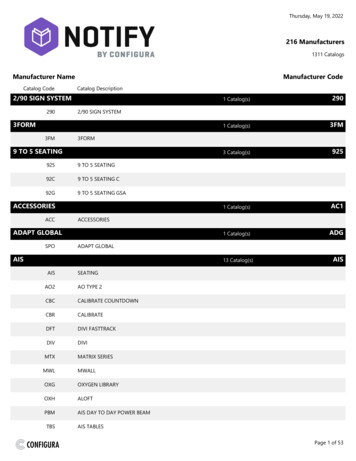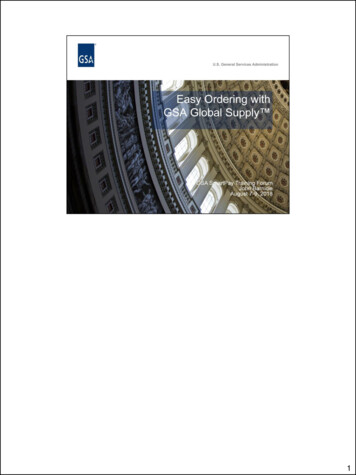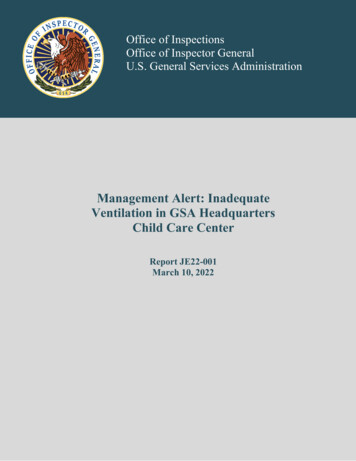
Transcription
The Osceola Mudflow from Mount Rainier: Sedimentology and hazardimplications of a huge clay-rich debris flowJames W. VallanceKevin M. Scott}U.S. Geological Survey, 5400 MacArthur Boulevard, Vancouver, Washington 98661ABSTRACTThe 3.8 km3 Osceola Mudflow began as a water-saturated avalanche during phreatomagmatic eruptions at the summit of MountRainier about 5600 years ago. It filled valleys of the White River system north and northeast of Mount Rainier to depths of more than100 m, flowed northward and westward more than 120 km, coveredmore than 200 km2 of the Puget Sound lowland, and extended intoPuget Sound. The lahar had a velocity of 19 m/s and peak dischargeof 2.5 106 m3/s, 40 to 50 km downstream, and was hydraulicallydammed behind a constriction. It was coeval with the Paradise lahar,which flowed down the south side of Mount Rainier, and was probablyrelated to it genetically.Osceola Mudflow deposits comprise three facies. The axial faciesforms normally graded deposits 1.5 to 25 m thick in lowlands and valley bottoms and thinner ungraded deposits in lowlands; the valley-sidefacies forms ungraded deposits 0.3 to 2 m thick that drape valleyslopes; and the hummocky facies, interpreted before as a separate(Greenwater) lahar, forms 2–10-m-thick deposits dotted with numerous hummocks up to 20 m high and 60 m in plan.Deposits show progressive downstream improvement in sorting, increase in sand and gravel, and decrease in clay. These downstreamprogressions are caused by incorporation (bulking) of better sortedgravel and sand. Normally graded axial deposits show similar trendsfrom top to bottom because of bulking. The coarse-grained basal deposits in valley bottoms are similar to deposits near inundation limits.Normal grading in deposits is best explained by incremental aggradation of a flow wave, coarser grained at its front than at its tail.The Osceola Mudflow transformed completely from debris avalanche to clay-rich (cohesive) lahar within 2 km of its source because ofthe presence within the preavalanche mass of large volumes of pore water and abundant weak hydrothermally altered rock. A survey of cohesive lahars suggests that the amount of hydrothermally altered rock inthe preavalanche mass determines whether a debris avalanche willtransform into a cohesive debris flow or remain a largely unsaturateddebris avalanche. The distinction among cohesive lahar, noncohesivelahar, and debris avalanche is important in hazard assessment becausecohesive lahars spread much more widely than noncohesive lahars thattravel similar distances, and travel farther and spread more widely*Present address: Department of Civil Engineering and Applied Mechanics,McGill University, 817 Sherbrooke Street West, Montréal, Québec H3A 2K6,Canada. E-mail address: james@fuego.civil.mcgill.cathan debris avalanches of similar volume. The Osceola Mudflow is documented here as an example of a cohesive debris flow of huge size thatcan be used as a model for hazard analysis of similar flows.INTRODUCTIONThe Osceola Mudflow began as an avalanche or a series of avalanchesat the summit of Mount Rainier in west-central Washington State about5600 yr (4800 radiocarbon yr) B.P. (Crandell, 1971). It is the largest of several catastrophic lahars that swept down the White River drainage duringHolocene time and one of the world’s largest lahars (Fig. 1).The distribution of the Osceola Mudflow, many of its features, and thecharacter of the eruptions that produced it were investigated in the seminalwork of Crandell and Mullineaux on the surficial geology of MountRainier and vicinity (Crandell and Waldron, 1956; Crandell, 1963a, 1963b,1969, 1971; Mullineaux, 1965a, 1965b, 1974). Many of the ideas presented here are naturally similar to those of Crandell and Mullineaux; however, some of our conclusions differ from their conclusions, and our resultsrequire a revision of the events that led to and culminated in the OsceolaMudflow. In particular, we investigate the stratigraphic relationships oftephra units to the Osceola Mudflow, show that all of these units probablywere generated during a single phreatomagmatic eruptive episode, and infer that the eruption involved laterally directed explosions. We simplify theinferred pre-Osceola sequence by showing that the Paradise and Greenwater lahars, thought by Crandell (1971) to predate the Osceola Mudflow, arecontemporaneous and, specifically, that the Greenwater lahar is actually ahummock-rich facies of the Osceola.At Mount St. Helens after 1980, detailed stratigraphic and sedimentological study of clay-poor lahars illustrated the facies gradations from topto bottom of outcrops, from valley bottom to inundation limit, and with distance downstream (Scott, 1988). Pierson and Scott (1985) and Scott (1988)showed how the lahars developed from water floods that incorporated sediment by erosion and how they evolved downstream to more dilute (hyperconcentrated) flow. There is as yet no similarly detailed study of a clay-richavalanche-induced lahar like the Osceola Mudflow. We discuss the facieschanges, sedimentology, and inferred behavior of the Osceola Mudflow,show how these characteristics differ from those of typical clay-poor lahars, and suggest that they are typical of huge clay-rich lahars. We examine lateral, longitudinal, and vertical gradations in deposits of the Mudflowand make detailed observations of changes in the character of deposits between lowlying areas and inundation limits in order to infer its behavior.We thereby infer that the Osceola Mudflow was most erosive during waxing and peak flow, and that it progressively incorporated sediment as itData Repository item 9714 contains additional material related to this article.GSA Bulletin; February 1997; v. 109; no. 2; p. 143–163; 14 figures; 6 tables.143
VALLANCE AND SCOTTFigure 1. Map showingdistribution of Osceola Mudflow and Paradise lahar(modified from Crandell,1971, plate 3). Distribution ofOsceola Mudflow in subsurface from Dragovich et al.(1994). Distributions of tephra layers F and S (Mullineaux, 1974) shown nearMount Rainier. Sections 1, 2,3, and A–A′ shown in Figure 7.moved down valley. On the basis of facies and sedimentological variations,we suggest that the normal grading common in low-lying deposits is bestexplained by incremental deposition of a debris wave that is coarser andbetter sorted near its front than at its tail.This study is a part of a more comprehensive effort to reevaluate debrisflows and their hazards at Mount Rainier (Scott et al., 1995; Scott and Vallance, 1995). A growing body of evidence suggests that there is a completegradation between sector-collapse–induced debris avalanches and lahars atvolcanoes (Neall and Alloway, 1986; Palmer et al., 1991; Carrasco-Núñezet al., 1993; Vallance, 1994a, 1994b; Scott et al., 1995). We discuss the gradation between sector-collapse–induced debris avalanches and huge clayrich lahars and its significance with respect to hazard appraisal.TERMINOLOGY AND RELATED DISCUSSIONDebris flow is a term used here to indicate any flowing mixture of debrisand water having sediment concentration greater than 60% by volume or80% by weight. Flows having higher water contents, so high that they pos-144sess fluvial characteristics yet carry very high sediment loads, are termedhyperconcentrated flows; depth-integrated sediment concentrations between 20 and 60 vol% or 40 and 80 wt% characterize such flows (Beverage and Culbertson, 1964). We use lahar for a debris flow originating at avolcano and lahar-runout flow for a downstream transformation from debris flow to hyperconcentrated stream flow. We refer to lahar and laharrunout deposits as lahars and lahar runouts where the meaning is clear.Mudflow, in the sense of a debris flow having a greater than 50% sand-,silt-, and clay-size solid fraction (Crandell, 1971; Varnes, 1978), is not usedin this paper, and the term is used only in the formation name, OsceolaMudflow.A more significant criterion for distinguishing among debris flows is theclay fraction. We empirically separate cohesive debris from noncohesivedebris by the ratio of clay to total sand, silt, and clay (sand-, silt-, and claysize fractions) and suggest that a ratio of about 0.05 divides cohesive andnoncohesive debris flows (Fig. 2). In using this terminology, we intend todistinguish between noncohesive flows, which commonly begin as waterfloods that incorporate sediment through erosion then transform down-Geological Society of America Bulletin, February 1997
OSCEOLA MUDFLOW, MOUNT RAINIERthe Fraser glaciation banked up against the Cascade Range mountain frontat the mouth of the White River during late Wisconsin time and formed asequence of kame terraces that extends almost 10 km up the White Riverdrainage near Mud Mountain (Fig. 1). The glacier retreated from themountain front by about 12,000 yr B.P., leaving the White River flowingwesterly across the Puget Sound lowland along the present course of SouthPrairie Creek (Fig. 1; Crandell, 1963b). Alpine glaciers of Evans Creek agecovered much of Mount Rainier and vicinity, advanced to within severalkilometres of the confluence of the West and Main forks of the WhiteRiver, then retreated by about 17,000 yr B.P. (Crandell and Miller, 1974).Three exotic tephras and one from Mount Rainier are useful stratigraphicmarkers in the White River valley, because they are widespread and easilyidentified in the field. The tephras include layer O from Mount Mazama,layer Y from Mount St. Helens, layer C from Mount Rainier, and layer Wnfrom Mount St. Helens (Mullineaux, 1974) (Table 1).AGE, ORIGIN, AND STRATIGRAPHIC RELATIONSHIPS OFTHE OSCEOLA MUDFLOWAge of the Osceola MudflowFigure 2. Graph showing clay/(sand silt clay) of cohesive andnoncohesive lahars from Mount Rainier and Mount St. Helens versusdownstream distance from the volcano.Eight radiocarbon ages on wood from Osceola Mudflow deposits rangefrom 4425 310 to 5040 150 yr B.P. (Table 2, numbers 1, 3, 4, 6, 7, 9, 10,and 12). The 4425 310 yr B.P. age on wood from a quarry near Huckleberry Creek (sample 1, Table 2) seems anomalously young, but a secondage, 4980 200 yr B.P. (sample 9, Table 2), on wood from the same outcrop, is within the range of anticipated statistical error for the samples. Theaverage of the eight radiocarbon ages with one standard deviation of confidence is 4832 43 yr B.P. (Stuiver and Reimer, 1993). The average ageof the Osceola Mudflow, corrected for changes in atmospheric 14C, is between 5603 and 5491 yr B.P. and has a calibration-curve intercept of5588 yr B.P. (Stuiver and Reimer, 1993). The calendar age of the Mudflowis thus about 5600 yr B.P.Source of the Osceola Mudflowstream to more dilute flows, and cohesive flows, which typically begin aswater-saturated avalanches that transform downstream to debris flows andremain debris flows to their termini. Because the terms are defined by clayin the matrix rather than by their origin or their tendency to transformdownstream to hyperconcentrated flow, some cohesive lahars like theNorth Fork lahar (Fig. 2) and the Paradise lahar (Scott et al., 1995) straddlethe boundary. The term bulking is used as a general term for the incorporation of sediment in a flow by erosion at the flow boundary (Scott, 1988).In contrast to general deposition of bulk sediment, debulking is used as aterm for the preferred deposition of certain particle sizes (generally coarseparticles) from the flowing debris as it moves downstream.TOPOGRAPHIC AND GEOLOGIC SETTINGMount Rainier volcano is the highest (4392 m) and most extensivelyglaciated peak in the Cascade Range. Glacier ice covers 92 km2 of the volcano and has a volume of 4.4 km3 (Driedger and Kennard, 1986). The Emmons glacier (11.2 km2 area, 0.67 km3 volume) and Winthrop Glacier(9.1 km2 area, 0.52 km3 volume) descend the northeast and north sides ofMount Rainier at the headwaters of the Main and West forks of the WhiteRiver. These two rivers flow northeast and north from Mount Rainier, joinabout 45 km downstream near Greenwater, and flow westward to PugetSound (Fig. 1).The Puget Sound lowland in the vicinity of the Osceola Mudflow is underlain by glacial drift of Vashon age (Crandell, 1963b; Mullineaux, 1965a,1965b). The last major (Vashon) advance of the Puget glacier lobe duringSeveral authors (Russell, 1898; Matthes, 1914; Coombs, 1936; Fiske etal., 1963; Crandell, 1963a) recognized that Mount Rainier was once higherthan it is now. Crandell (1963a) first inferred that the “missing summit” hadavalanched down the northeast side of Mount Rainier to form the OsceolaMudflow. The resulting depression might have had the form of a semicircular amphitheater open to the northeast. The depression has since largelybeen filled by ice and by lava flows extruded at a central vent, but RussellCliff, Liberty Cap, Point Success, and Disappointment Cleaver still definepart of its outline (Figs. 1 and 3). The volume of the missing summit can becalculated by noting that the outline of the depression is about 1.8 km acrossand inferring the original height of the summit and depth of the depression.By projecting dipping lava beds upward, Fiske et al. (1963) estimated thepre-Osceola height of Mount Rainier as 4900 m. The outlines of theMount St. Helens, May 18, 1980 crater (2 km across) and the Osceola depression (1.8 to 2.0 km across) suggest that they are similar in size. Therefore, we assume that the depth of the Osceola depression was about 0.6 km,about the depth of the Mount St. Helens crater. Assuming that the missingvolume of Mount Rainier can be modeled as a cone and cylinder, each having a base of 1.8 to 2 km in diameter and a height of 0.6 km, the missing volume of Mount Rainier is calculated to be 2.0 to 2.5 km3.An important discovery (Crandell, 1971) was the presence of clay andother alteration minerals like smectite, kaolinite, halloysite, mica, cristobalite, opal, and hematite in Osceola deposits. Frank (1985; 1995) later discovered the same minerals in outcrops of hydrothermally altered rock highon the edifice. The presence of these distinctive alteration minerals withinGeological Society of America Bulletin, February 1997145
VALLANCE AND SCOTTTABLE 1. AGES AND DISTINGUISHING CHARACTERISTICS OF IMPORTANT TEPHRAS AT MOUNT butionThickness(cm)Grainsize(mm)OtherWnSt. HelensA.D.* 1480Eastern halfof study area0–4 2White sand-sized pumicenear surfaceCRainier2200East to north-northeastof summit0–305–50Brown pumice scoria andlithic lapilli at surfaceYSt. Helens3500†Eastern two-thirdsof study area0–250.5–3Yellow coarse sand-sizedpumice and several finegrained layersBRainierca. 4500to 4800Southeast to eastof summit0–71–50Reddish-brown ash withscattered bombs andlapilliHRainierca. 4500to ca. 4800Southeast to east-northeastof summit0–51–10Brown to gray ash withscattered lapilliFRainierca. 4800South-southeast to northnortheast; lowest unit isto the northeast0–150.002–10Light colored clayey ashand scattered lapilli,three layersSRainier4800to 5000Northeast of summit,narrow lobe0–1500.5-1000Angular blocks in grayashNRainier4800to 5200East-southeast to northeastof summit0–41–10DRainier5800 to 6400East-southeast to eastnortheast of summit0–1550–200LRainier6400Southeast to eastof summit0–20 50Brown pumice betweendark gray ash bedsARainier6400to 6700Southeast to north-northeast0–3 30White pumice in brownashOMazama6850§Eastern two-thirdsof study area2–40.01–0.4Reddish-brownlapilli in coarse ashReddish-brown scoriaand lapilliOrange to cream coloredvery fine sand- to silt-sizedashNote: Adapted from Mullineaux (1974). Unless otherwise noted, ages are given in terms of radiocarbon years B.P.*Yamaguchi (1983)—a calendar age based on correlation of tree rings.†Mullineaux (1986).§Bacon (1983).remnants of the pre-Osceola edifice and within Osceola deposits indicatesthat the Mudflow began as a huge avalanche of previously altered rock(Crandell, 1971).Relation of the Osceola Mudflow to Tephra Layers F and STephra layer S (Table 1) comprises a poorly sorted mixture of angularfragments and ash of lithic Mount Rainier andesite, which crops out alongthe ridge between Dege Peak and Sunrise in Mount Rainier National Park(Mullineaux, 1974). The tephra overlies tephra layers O and D (6850 yrB.P. and 5800 to 6400 yr B.P., Table 1) and directly underlies tephralayer F. On Goat Island Mountain, a runup deposit of the Osceola Mudflowoverlies, with no intervening weathering zone, 2 or more meters of MountRainier andesite rubble that we interpret as layer S. Crandell (1971) suggested that layer S might be associated with the eruption that produced theGreenwater lahar; we agree with Crandell, but believe that the Greenwateris really part of the Osceola Mudflow.Mullineaux (1974) inferred that the Osceola Mudflow and tephra layerF were genetically related because he observed similar clay minerals likesmectite, kaolinite, and mixed layer clay in both of these units but not inother lahars and tephra layers of similar age. A radiocarbon date from peatbeneath set F coincides with older limiting dates for the Osceola Mudflow(Table 2). We discovered a remnant of layer F overlying an Osceola deposit146that was emplaced when the Mudflow ran more than 100 m up on the flankof Goat Island Mountain (along a ridge to the north at an altitude of2054 m). Otherwise, tephra set F is not present on top of the Osceola Mudflow despite the presence of that layer on valley sides and ridge tops adjacent to deposits of the Osceola (Mullineaux, 1974; this study). Further, theOsceola Mudflow rests directly on Pleistocene till, bedrock, or noncohesive lahar deposits rather than set F within the tephra’s known area of extent. These relationships are consistent with the fall of tephra set F after initiation of the Osceola Mudflow but, at most localities, before it stoppedmoving. Its position high on a ridge crest directly opposite Mount Rainiersuggests that the runup debris was part of the leading edge of the Osceolaavalanche, and we infer that the runup was deposited early in the eruptionsequence, before or during the fall of tephra set F.Mullineaux found that set F consists of at least three layers. The oldestlayer, Fl, is mainly distributed northeast of the volcano and is composedprimarily of lithic fragments and clay minerals; the second layer, Fm, is distributed east to southeast of Mount Rainier, contains some lithic ash, but ismainly composed of pumice and pyrogenic crystals; the third layer, Fu, isalso distributed to the northeast and includes abundant clay minerals andlithic fragments as well as significant proportions of pumice and brokenpyrogenic crystals (Fig. 1). The three layers are inferred to have been deposited within a short time, perhaps less than an hour, because no evidenceof erosion or weathering exists between them.Geological Society of America Bulletin, February 1997
OSCEOLA MUDFLOW, MOUNT RAINIERTABLE 2. RADIOCARBON AGES PERTAINING TO THE OSCEOLA MUDFLOWSamplenumberRadiocarbonageUnit andstratigraphic positionSample description andlocality14425 310Osceola MudflowBark from an outcrop at aquarry near Huckleberry Creek24625 240Paradise laharCharcoal from an outcropnear Ricksecker Point34700 250Osceola MudflowWood from an outcropalong the bank of thePuyallup River near 00 60Osceola MudflowWood from an outcropalong the bank of thePuyallup River near Sumner54730 320Paradise laharCharcoal fragments fromnear the upper part ofthe deposit, Nisqually Rivervalley near National64800 300Osceola MudflowLog from an outcropnear Mud Mountain Dam74950 300Osceola MudflowLog from an outcropalong a roadcut of Highway410 near Buckley84955 585Soil layer underlyingthe Paradise laharand overlying layer OWood from an outcropnear Longmire94980 200Osceola MudflowWood from an outcrop at aquarry near Huckleberry Creek105010 80Osceola MudflowTwigs from a well boring4 km north of Sumner115020 300Soil horizon belowtephra layer FPeat from below tephra layer Fin Cowlitz Park 6 km southeastof Mount Rainiermagmatic component. After the magmatic eruption of Fm, tephra layer Fu,with its increased proportion of hydrothermal clay, its substantial proportion of juvenile particles, and its distribution to the northeast, indicates a return to phreatomagmatic explosions.The Osceola Mudflow is about an order of magnitude larger than theother cohesive lahars that occurred at Mount Rainier during Holocene timeand is the only one clearly related to an eruption. The intrusion of magmato shallow depths and explosive activity during the eruption of tephra layerF probably contributed to the destablization of a large volume of the edifice and to the enormous size of the Mudflow.125040 150Osceola MudflowWood from a depth of 80 m ina well boring near AuburnRelation of the Osceola Mudflow and the Paradise Lahar135230 235Soil horizon belowthe Osceola Mudflow and 2 olderlahars but abovelayer OCharcoal fragments in anorganic-rich soil zone exposedalong the White River about1 km upstream of Buck Creek146075 320Lahar underlyingtwo pre-OsceolalaharsWood fragment from a laharexposed along the White Riverabout 1 km upstream of BuckCreekNote: Samples 1, 2, 5, 8, 9, 13, and 14 are from Scott et al. (1992); samples 3, 6,and 7 are from Crandell (1963b); sample 11 is from Mullineaux (1974); samples 4and 10 are from Dragovich et al. (1994); and sample 12 is from Luzier (1969). Morecomplete locality descriptions were given in those papers.Tephra layers S, Fl, and Fu all have characteristics that suggest laterallydirected, phreatic or phreatomagmatic eruptions. The distribution of theselayers in narrow lobes suggests explosions with strong lateral componentsor vertical eruption during very strong unidirectional wind. Each of thelobes has an axis that roughly corresponds to the medial axis of the scarpinferred to have been left by the Osceola sector collapse (Fig. 1). Such a coincidentally fortuitous wind direction seems unlikely, especially becausethe dominantly magmatic tephra layer, Fm, is distributed in a broad arceast-southeast of the volcano rather than northeast like the others (Fig. 1).Tephra layer S is limited to a very narrow lobe to the northeast and containsangular blocks that can have no origin other than as laterally projected ballistic fragments (Mullineaux, 1974). The deposit contains no juvenile material and thus probably resulted from phreatic explosions. Tephra layer Flcomprises lithic lapilli, hydrothermal clay minerals, and minor amounts ofjuvenile pumice, glass shards, and crystals that suggest the addition of aFigure 3. Photograph of Mount Rainier from north, showing postOsceola edifice filling Osceola avalanche scarp, defined by Disappointment Cleaver, Russell Cliff, Liberty Cap, and Point Success (notin the field of view).The Paradise lahar is a large (50 to 100 106 m3; Crandell, 1971) cohesive lahar that crops out in the Nisqually River valley at least as far downstream as National (Fig. 1). The lahar originated in avalanches of partly altered rock near the summit. It temporarily filled valleys to depths as greatas 300 m but attenuated rapidly downstream (Crandell, 1971). Its downstream equivalent is not observed below National, but it probably extendedfarther (Scott et al., 1995). Despite the tremendous depths to which it filledvalleys, the lahar left behind only thin (0.5 to 2 m thick) deposits and failedto erode the even thinner (less than 5 cm) deposits of layer O at many locations on valley-side slopes. Its voluminous, sharply peaked, and rapidlyattenuating character records the sudden collapse of a portion of the uppercone, possibly triggered by explosions associated with layer S or Fl. Boththe smaller clay-size fraction and clay-mineral content of the deposits relative to those of the Osceola Mudflow deposits suggest an origin from lessaltered parts of the edifice.Stratigraphy and radiocarbon ages suggest that the Osceola Mudflowand the Paradise lahar are coeval (Scott et al., 1995). On the valley sideabout 300 m above the headwaters of the Nisqually River, scatterded lapilliof layer Fm overlie the Paradise lahar. Charcoal fragments from within thelahar at two localities have ages of 4625 240 and 4730 320 yr B.P., anda third age on wood from a soil beneath the lahar is 4955 585 yr B.P.(Table 2). The average of the first two radiocarbon ages, 4663 192 (Stuiver and Reimer, 1993), overlaps and is thus consistent with the radiocarbon age of the Osceola Mudflow. The average age of the Paradise lahar,corrected for changes in atmospheric 14C, is between 5596 yr B.P. and5048 yr B.P. and has calibration-curve intercepts of 5443, 5414, and5324 yr B.P. (Stuiver and Reimer, 1993).Geological Society of America Bulletin, February 1997147
VALLANCE AND SCOTTEruption NarrativeSometime after about 5200 14C yr B.P. but before the Osceola Mudflowwas formed, pyroclastic eruptions produced pumice and ash of tephra layerN that were deposited east and northeast of the volcano (Fig. 4). At least threenoncohesive lahars flowed down the White River drainage at about this sametime, and one or more moved as far as the Puget Sound lowland (Buck Creeklahar assemblage, Fig. 4). Two of the lahars contain breadcrusted bombs nearthe volcano, and all contain fresh angular blocks of andesite from MountRainier; these observations suggest that the lahars formed when hot pyroclastic debris avalanched down the Emmons and Winthrop Glaciers. Thepresence of breadcrusted bombs in the lahars suggests that they were formedduring pyroclastic eruptions by pyroclastic flows or hot avalanches thatswept across firn and glacier ice. Whether the same eruption produced layerN and the lahars is not known, but the similar time constraints (Fig. 4) suggest that the eruptions could be genetically related.There was a repose of as much as several hundred years or as little as afew hours, then the eruptive sequence that triggered the Osceola Mudflow,recorded by tephra layers S(?), Fl, and Fm, apparently began with phreaticexplosions, progressed through phreatomagmatic explosions to magmaticactivity, and finally retrogressed to mixed phreatic explosions and magmatic activity. The sequence of tephras with apparent lateral components,S, Fl, and Fu, shows an increase in content of hydrothermal clay mineralswith time and suggests that as the eruption progressed it involved rocksdeeper within the edifice.Edifice construction ensued for several centuries after the climacticOsceola event. The eruption of small volumes of tephra (layers H and B)probably corresponds to minor explosive activity that occurred duringthis period of magmatism. The tephra stratigraphy suggests that explosive activity at Mount Rainier ceased for nearly 2000 yr after ca. 4500 yrB.P. By the time Mount Rainier became active again, ca. 2300 yr B.P., thedepression had been filled by nonexplosive lava flows so that pyroclasticflows from the central vent spilled westward into the Puyallup Riverdrainage.DISTRIBUTION, VOLUME, AND PHYSICALCHARACTERISTICS OF THE OSCEOLA MUDFLOWThe distribution of the Osceola Mudflow is shown in Figure 1. Withinabout 8 km of its source, the proximal part of the deposit is present onSteamboat Prow, in the Inter Fork valley, and on ridges overlooking theWinthop Glacier. Below the Winthrop and Emmons Glaciers and downvalley for about 70 km, the medial part is present throughout the Main andWest Forks of the White River valley. Typically the Osceola Mudflowforms 5–20-m-thick fills in valley bottoms and 30–200-cm-thick veneerson steep valley sides as much as 200 m above the present river level. Its distal part blankets 211 km2 of the Puget Sound lowland (Crandell, 1971) andunderlies 157 km2 of the now-sediment-filled Duwamish and Puyallupembayments of Puget Sound, where water wells penetrate the deposit atdepths of up to 100 m (Dragovich et al., 1994).Figure 4. Schematic sections showing relationship between tephra layers and lahar assemblages in White River drainage basin.148Geological Society of America Bulletin, February 1997
OSCEOLA MUDFLOW, MOUNT RAINIERTABLE 3. ORIGINAL AREA AND VOLUMEOF THE OSCEOLA MUDFLOWLocationArea(km2)Volume( 106 m3)Valleys upstream fromPuget Sound lowland150930Puget Sound lowland2121370South Prairie Creek andPuyallup River valleys(all subsurface)28*700 well logs, Dragovich and his colleagues concluded that at least1.26 km3 of Osceola debris spread underwater and covered at least157 km2 in Puget Sound. The tremendous volume of Osceola debris andgreatly increased sedimentation during post-Osceola time combined to fillthe Duwamish and Puyallup arms of Puget Sound.Axial, Valley-Side, and Hummocky Facies240*Puyallup and Duwamishembayments of Puget Sound5600 yr B.P. (all subsurface)157*1260*Total547†3800†*Subsurface data from Dragovich et al. (1994).†Total area and volume are minimum values.Volume of the Osceola MudflowThe volume of 3.8 km3 given for the Osceola Mudflow in Table 3 isbased on examination of outcrops, analysis of more than 200 well logs, anddata provided to us by Joe Dragovich and Pat Pringle of the WashingtonDepartment of Natural Resources. To compute the volume, the areal extentof the deposit was divided into 25 parcels and an average thickness was determined for each parcel. The volumes of the parcels were then summedand averaged over distance to find the center of mass. The center of massof the Osceola deposit is located about 80 km downstream from MountRainier. The Osceola volume of 3.8 km3 plus the Paradise volume of 0.05to 0.1 km3 is more than the 2 to 2.5 km3 volume of the “missing summit.”Dilation of the original avalanche mass and bulking of exotic material account for the difference in volume.Appreciable volumes of Osceola debris underlie the Puyallup River valley and the Puyallup and Duwamish embayments of Puget Sound (Fig. 1).Luzier (1969) discovered the Osceola Mudflow at a depth of
Three exotic tephras and one from Mount Rainier are useful stratigraphic markers in the White River valley, because they are widespread and easil y identified in the field. The tephras include layer O from Mount Mazama, layer Y from Mount St. Helens, layer C fr om Mount Rainier , and la yer Wn from Mount St. Helens (Mullineaux, 1974) (Table 1).










